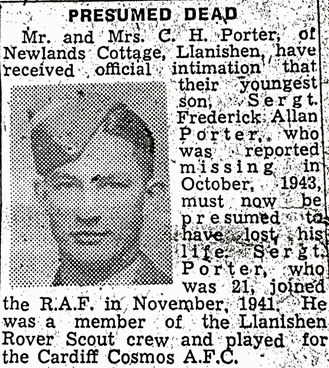Frederick Allan Porter

FREDERICK ALLAN PORTER
Fred Porter was born on 9 May 1922, to Charles Henry and Anna Porter (maiden name Musto) and they lived at Newlands Cottage on Fidlas Road (now numbered 170). He was the youngest of four children, which included elder brother Alfred and three older sisters: Edith, Mona and Margaret. His father Charles had a well-established business as a painter and decorator.


Like John Morgan and Len Gill, Fred was a member of the local Scout Group and joined the RAFVR in November 1941. In May 1943 he was being trained for aircrew with 81 Operational Training Unit at RAF Sleap, near Shrewsbury. It was there he joined pilot William Parmenas Cameron's crew and went with him to 1662 Heavy Conversion Unit for their final training in Lancaster bombers. They eventually became part of 625 Squadron in Bomber Command.
Information provided by Philip E. Townsend
Philip Townsend is related to William Parmenas Cameron (Bill) who signed up with the Royal Canadian Air Force (RCAF) and became the pilot of a Lancaster Bomber, Mark III series, Serial Number JA714, Radio Call Sign ‘CF-R’. He was attached to the 625 Squadron (“CF”), Group 1 based at Kelstern, Lincolnshire. Bill only flew on two missions: his first was as a second pilot on 18 October 1943 to Hanover, Germany and his second, the first and last with his own crew, was intended for Leipzig, Germany on 20 October 1943. En-route over the island of Texel, Holland their Lancaster was shot down and crashed into the Wadden Sea, south east of Oosterend. Six of the crew including Bill and Fred Porter are officially ‘Missing in Action’ as their bodies were never recovered. The body of the Navigator Albert Snook was recovered from the sea though and is buried in the General Cemetery on the Island of West Terschelling. This crew was the first operational loss for the Squadron. Its members were:
- Flying Officer – William Parmenas Cameron – Pilot – RCAF – Missing in Action
- Sergeant – John Wilson Diggle – Flight Engineer – RAF – Missing in Action
- Sergeant – John Henry Hawkins – Wireless Operator – RAF – Missing in Action
- Flying Officer – Clifford Wallace McFarlane – Air Gunner – RCAF – Missing in Action
Sergeant – Frederick Allan Porter – Air Gunner – RAF – Missing in Action
- Flying Officer – Albert Vernon Snook – Bomb Aimer – RCAF – Killed in Action
- Sergeant – Leonard Wild – Navigator – RAF – Missing in Action
Fred Porter was listed as the rear gunner in the Lancaster, often called the “Tail-end Charlie”. The planned route for their mission to Leipzig is shown on the map below, also provided by Philip Townsend.
 See: https://mapsengine.google.com/map/viewer?mid=zgv8t3QTOv4M.kUgIHYCGcZlc
See: https://mapsengine.google.com/map/viewer?mid=zgv8t3QTOv4M.kUgIHYCGcZlc
Commonwealth War Graves details for Fred Porter


Article from the Western Mail reporting the loss of Fred Porter:

The aircraft was brought down, apparently by flak, at 19.18hrs, near the coast of the Dutch Frisian island of Texel. From local ground reports about JA714 - "It was a tremendous fireball, of which some parts were gliding down, also burning. The flying machine was falling many feet in height, before it came under control again for a while. The frightening light of this inferno in the dark night was intense, because the craft was loaded with incendiary bombs, which all started to burn. Then the plane was ‘rising up‘ for one last occasion, before everything was finished."
The Lancaster came down on the mud flats of the Wadden Sea, about 3 km east of Oosterend village on Texel island. According to the Dutch Dept of Defence, the crash location is: 58' 75 N and 04' 53' 10 E.
Crews of bombers spotted the downed aircraft while it was laying in the mud and described how it was burning for some time. The incendiaries were spread around the wreckage of the plane, and were still spitting fire. Others observed that it was still burning on their return journey.
From that crew of seven men, all were killed, and only one body, that of the Canadian Air Bomber, F/O Albert Snook, was recovered. He was washed ashore on Terschelling Island and it was at the cemetery there that he was buried. When the remaining eleven aircraft returned to Kelstern most reported an uneventful trip with poor visibility due to the heavy cloud over the target area.
Map showing where Fred Porter’s plane crashed:

RAF RECORD OF 625 SQUADRON'S MISSION TO LEIPZIG ON 20 OCT 1943:
Fred Porter's Lancaster is second from the bottom of the page shown below. It took off at 17.47 but there is no return time of course. The details then recorded are, "Target LEIPZIG. Aircraft failed to return, no news after take-off."
The record of the preceding Lancaster on the report, which took off at 17.35, gives an indication of what may have been encountered by Fred's crew. It reads:
"On the way to target, aircraft attacked by enemy fighter, successful evasive action taken. 2 more enemy fighters attacked in the TEXEL area, evasive action taken, and by return to offensive 1 enemy fighter shot down and the second fighter damaged. Rear turret U/S [out of action]. Proceeded to attack target at 21.09, bombs being dropped from a height of 21,000'. Scattered fires seen."

Fred’s father’s business, as advertised in the Llanishen Parish Magazine:
[Photo from Robert Davies] Left to right: Len Gill, Fred Porter, John Morgan and their friend Cesc Mealins.